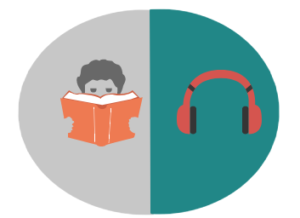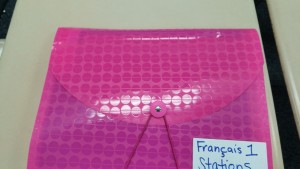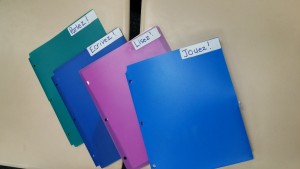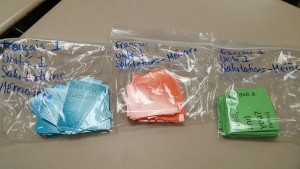 While I was completing my French walkabout (pictures to follow!) a group of teachers from my district met to design a curriculum map in order to facilitate consistency across the district. While I wasn’t able to participate in this work, here are the steps I’d suggest for designing curriculum, based on my current understandings of proficiency-based teaching and curriculum-design processes.
While I was completing my French walkabout (pictures to follow!) a group of teachers from my district met to design a curriculum map in order to facilitate consistency across the district. While I wasn’t able to participate in this work, here are the steps I’d suggest for designing curriculum, based on my current understandings of proficiency-based teaching and curriculum-design processes.
Step 1: Choose Unit Themes
I order to provide an overarching organization across levels and to avoid repeating topics, I would select the themes that would be addressed at each level. Because our school year is organized into four, nine-week quarters, I would choose about eight broad themes for each level. I would rely heavily on NCSSFL-ACTFL Can-Do Statements for the targeted proficiency level when choosing these themes in order to ensure that they are appropriate for the students’ proficiency level. Since the Novice-Mid Can-Do Benchmark (Presentational Speaking) states “I can present information about myself and some other very familiar topics…” I would choose themes such as Introductions, What I like/dislike, My Family and Friends, Places I Go, My Activities, My School, Where I live, What I eat, etc. for French I. Because the Novice-High Can-Do Benchmark (Interpersonal Communication) says, “I can usually handle short social interactions in everyday situations” I would choose themes that are slightly outside the students’ immediate environment such as Shopping for Groceries, Buying an Outfit, Visiting the Doctor, Going out with Friends, etc. for French 2. I would also begin introducing cross-curricular content themes such as topics related to geography, history, and Francophone stories at this level, as these topics are clearly suggested by the Can-Do Statements. In French 3, where the targeted proficiency level is Intermediate Low, I would suggest a greater variety of cultural and cross-curricular themes such as Travel, Education, Environment, Art, History, etc. These themes are consistent with the Intermediate Low Benchmark (Presentational Speaking) which states, “I can present information on most familiar topics” and will prepare the students for the AP curriculum in our level 4 classess. These suggestions are purposely broad in nature, and I would suggest phrasing them in a way that was consistent with whatever curriculum format or template is being used.
Step 2: Write Proficiency-Based Can-Do Statements for Each Theme
Having chosen the themes for each level, I would then write a Can-Do Statement for each communicative mode/language skill. In some cases, one of the NCSSFL-ACTFL Can-Do Statement examples (those which are placed below the bold-print statements and next to a box) might already correspond to the chosen theme. In other cases, the language from the actual Can-Do could be modified to fit the unit theme. For example, in a French I unit on Likes/Dislikes, I would suggest using the following Can-Do Statements as they are written:
- Interpersonal Communication: I can answer questions about what I like and dislike.
- Presentational Writing: I can list my likes and dislikes such as favorite subjects, sports, or free-time activities.
- Presentational Speaking: I can say which sports I like and don’t like. (Although I would add other categories such as free-time activities.)
Because there are no specific NCSSFL-ACTFL Can-Do Statement examples for Interpretive Listening or Interpretive Reading that are related to the theme of Likes/Dislikes, I would write my own, incorporating the language used in the Can-Do Statement. ACTFL clearly invites us to do so, by including the blank line at the bottom of each list of examples. Here are some examples for this theme (the italicized words are taken from the published Can-Do’s):
- Interpretive Listening: I can recognize and sometimes understand words and phrases in a recording where someone discusses his/her likes and dislikes.
- Interpretive Reading: I can recognize words and phrases, about likes and dislikes such as sports and free-time activities.
Note: While some of the bold-print Can-Do Statements will be used in more than one unit, I think it’s important to make sure that each of these statements are included at least once in each curriculum map
Step 3: Create the Integrated Performance Assessment (IPA)
According to the principals of backwards design, the next step is to create the IPA that will serve as the summative assessment for the unit. The IPA should allow the students to demonstrate their mastery of the Can-Do statements. For specific suggestions on writing IPA’s, see this previous post. In my opinion, it is equally important that any curriculum development also address how the IPA will be assessed. Whether the ACTFL IPA manual rubrics, those developed by the Ohio Department of Education, or another source, in my opinion choosing a common rubric is a vital part of any curriculum planning process.
While these three steps might be adequate in designing a curriculum map, districts in which the teachers are less experienced in proficiency-based methodologies may find it helpful to design common lessons for some or all of the units. These lessons should be designed to provide the students with the background knowledge they need for the performance tasks on the IPA. This knowledge might include cultural competence related to the theme, as well as language skills such as the development of vocabulary and/or structures needed to complete the tasks.
Step 4: Design the Lessons
In my opinion, the best organizational structure for proficiency-based lessons is the “Authentic Lesson Cycle” described by Amy Lenord (http://www.amylenord.net/uploads/2/3/8/2/23820400/authenticlessoncycle.pdf). As this document describes, a proficiency-based lesson will enable the students to practice the skills that they will demonstrate on the IPA. Therefore, for each lesson the teacher will begin by selecting an authentic written and/or recorded text. I would suggest choosing texts that a) are suitable to the proficiency level of the students, b) contain key vocabulary and structures that the students will need for the unit, c) are rich in cultural content, and d) are similar in nature to the authentic resources used for the IPA. After selecting the resource, the teacher will create the interpretive task for the text. I suggest similar tasks as those that are used on the IPA so that the students can practice these skills and the teacher can give targeted feedback as well as collect formative assessment data. Once the students have completed the interpretive task and been given feedback (either as a whole-class discussion or by being given individualized written feedback), the students should then complete an interpersonal task based on the resource. This task will allow the students to practice the skills they will use on the IPA, but with more scaffolding. Therefore, students might have access to a list of helpful vocabulary, grammatical forms and/or sentence starters to be used in completing the task. As the teacher circulates among the dyads or tryads, s/he can provide individualized written or oral feedback on the students’ performance. In the last phase of Amy’s Authentic Lesson Cycle, the teacher assigns a presentational writing assignment in which the students personalize the cultural and linguistic competencies they have gained from the authentic resource. Depending on the teacher and students, these performances might be completed inside or outside of class. In my particular situation, I prefer to monitor my students as they complete these tasks. However, I often add an additional task, in which the students prepare a short oral presentation based on the Presentational Speaking Can-Do. I then randomly select 2-3 students to present their performance at the beginning of the following class period. Note: each of my authentic lessons usually require at least two 48-minute class periods, so a unit usually includes about five lessons.
I’d love to hear to hear feedback on these ideas from those of you who have been involved in designing a proficiency-based curriculum. Did you follow a similar process or did you go about designing your curriculum in a different way? What worked and what didn’t as you worked through the process?
 Recent conversations in my workshops and with my online PLN have me thinking a lot about the role of vocabulary lists in a communication-based classroom. As I look back at my evolution in teaching for proficiency, my use of vocabulary lists has changed significantly. For years I introduced the vocabulary in the textbook by having my students repeat the words on the list and then complete textbook activities, most of which were not communicative in nature. I then assessed my students’ memorization of this vocabulary in isolation through objective-style questions.
Recent conversations in my workshops and with my online PLN have me thinking a lot about the role of vocabulary lists in a communication-based classroom. As I look back at my evolution in teaching for proficiency, my use of vocabulary lists has changed significantly. For years I introduced the vocabulary in the textbook by having my students repeat the words on the list and then complete textbook activities, most of which were not communicative in nature. I then assessed my students’ memorization of this vocabulary in isolation through objective-style questions. 









